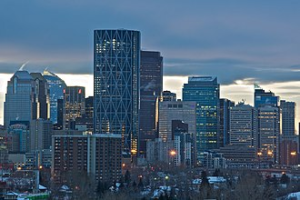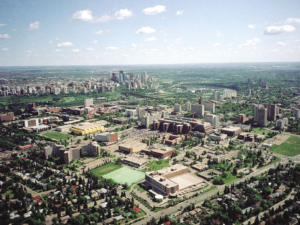
Alberta is the 6th largest province by area at 661,848 square kilometers, and the 4th most populous, being home to 4,067,175 people. Alberta’s capital is Edmonton, while Calgary is its largest city. The two are Alberta’s largest census metropolitan areas (CMAs) and both exceed one million people. More than half of Albertans live in either Edmonton or Calgary, which contributes to continuing the rivalry between the two cities. English is the official language of the province. The oil and gas industry is also a part of the province’s identity. Alberta’s economy is based on hydrocarbons, petrochemical industries, livestock, agriculture and frontier technologies. Alberta is renowned for its natural beauty, richness in fossils and for housing important nature reserves. Alberta is home to six UNESCO World Heritage Sites: The Canadian Rocky Mountain Parks, Dinosaur Provincial Park, the Head-Smashed-In Buffalo Jump, Waterton–Glacier International Peace Park, Wood Buffalo National Park and Writing-on-Stone Provincial Park.[20] Other popular sites include Banff, Canmore, Drumheller, Jasper, Sylvan Lake and Lake Louise.
The Alberta Legislative Building
Average high temperatures in January range from 0 °C (32 °F) in the southwest to −24 °C (−11 °F) in the far north. The climate is also influenced by the presence of the Rocky Mountains to the southwest, which disrupt the flow of the prevailing westerly winds and cause them to drop most of their moisture on the western slopes of the mountain ranges before reaching the province, casting a rain shadow over much of Alberta. Alberta has a humid continental climate with warm summers and cold winters. The province is open to cold arctic weather systems from the north, which often produce extremely cold conditions in winter.
Alberta’s economy was one of the strongest in the world, supported by the burgeoning petroleum industry and to a lesser extent, agriculture and technology. In 2013, Alberta’s per capita GDP exceeded that of the United States, Norway, or Switzerland,[85] and was the highest of any province in Canada at CA$84,390. This was 56% higher than the national average of CA$53,870 and more than twice that of some of the Atlantic Provinces.

Photo: Calgary Skyline At Sunset
Alberta has been a tourist destination from the early days of the twentieth century, with attractions including outdoor locales for skiing, hiking and camping, shopping locales such as West Edmonton Mall, Calgary Stampede, outdoor festivals, professional athletic events, international sporting competitions such as the Commonwealth Games and Olympic Games, as well as more eclectic attractions. According to Alberta Economic Development, Calgary and Edmonton both host over four million visitors annually. Banff, Jasper and the Rocky Mountains are visited by about three million people per year. Alberta tourism relies heavily on Southern Ontario tourists, as well as tourists from other parts of Canada, the United States, and many other countries.

Photo: The University of Alberta
Public and separate school boards, charter schools, and private schools all follow the Program of Studies and the curriculum approved by the provincial department of education (Alberta Education). Homeschool tutors may choose to follow the Program of Studies or develop their own Program of Studies. Public and separate schools, charter schools, and approved private schools all employ teachers who are certificated by Alberta Education, they administer Provincial Achievement Tests and Diploma Examinations set by Alberta Education, and they may grant high school graduation certificates endorsed by Alberta Education.
The University of Alberta, located in Edmonton and established in 1908, is Alberta’s oldest and largest university. The University of Calgary, once affiliated with the University of Alberta, gained its autonomy in 1966 and is now the second-largest university in Alberta. Athabasca University, which focuses on distance learning, and the University of Lethbridge are located in Athabasca and Lethbridge respectively.
In early September 2009, Mount Royal University became Calgary’s second public university, and in late September 2009, a similar move made McEwan University Edmonton’s second public university. There are 15 colleges that receive direct public funding, along with two technical institutes, Northern Alberta Institute of Technology and Southern Alberta Institute of Technology. Two of the colleges, Red Deer College and Grande Prairie Regional College, were approved by the Alberta government to become degree granting universities.
There are also many private post-secondary institutions, mostly Christian Universities, bringing the total number of universities to 12. Students may also receive government loans and grants while attending selected private institutions.
Universities in Alberta
Edmonton, the province’s capital city, is home to the University of Alberta, the province’s oldest and largest university; McEwan University; The King’s University; and Concordia University of Edmonton (not to be confused with Concordia University of Montreal). The French-language Campus Saint-Jean is part of the University of Alberta, offering programs to francophone and Francophile students.
There are five universities in Calgary: the University of Calgary, Ambrose University, Mount Royal University, St. Mary’s University and the Alberta University of the Arts.
The University of Lethbridge is based out of Lethbridge but also has a campus in Calgary.
Athabasca University, a distance learning university, has been based out of Athabasca since 1970.
Established in 1907 in Leduc, the independent publicly funded Burman University in Lacombe is the oldest university in Alberta. Formerly a university college, the Alberta Government granted the institution permission to change its status from “University College” to “University” in 2014.
In 2009, a bill was passed by the Alberta legislature which allowed the two public colleges that offered degrees (McEwan College in Edmonton and Mount Royal College in Calgary) to change their status to universities. Mount Royal College was renamed Mount Royal University on September 3, 2009 and Grant McEwan College became Grant McEwan University on September 24, 2009.
Most recently, The King’s University and Concordia University of Edmonton (2014) have obtained the right to change their respective names from University-College to University.
Publicly funded colleges
Alberta’s publicly funded colleges may offer academic upgrading, job readiness, apprenticeship, certificate, diploma, university transfer, baccalaureate and applied degree programs
| College | Location |
| Bow Valley College | Calgary |
| Grande Prairie Regional College | Grande Prairie |
| Keyano College | Fort McMurray |
| Lakeland College | Vermilion |
| Lethbridge College | Lethbridge |
| Medicine Hat College | Medicine Hat |
| NorQuest College | Edmonton |
| Northern Lakes College | Grouard |
| Olds College | Olds |
| Portage College | Lac La Biche |
Technical institutes
| Institution | City |
| Northern Alberta Institute of Technology | Edmonton |
| Southern Alberta Institute of Technology | Calgary |
| Canford Institute of Technology | Edmonton |
Private colleges
The following private colleges are accredited to grant degrees
| Institution | City |
| Alberta Bible College | Calgary |
| CLAC Career Development College | Edmonton |
| Newman Theological College | Edmonton |
| Peace River Bible Institute | Sexsmith |
| Prairie Bible Institute | Three Hills |
| Taylor College and Seminary | Edmonton |
| Vanguard College | Edmonton |
Alberta is well-connected by air, with international airports in both Calgary and Edmonton. Calgary International Airport and Edmonton International Airport are the fourth- and fifth-busiest in Canada, respectively.
Calgary, Edmonton, Red Deer, Medicine Hat, and Lethbridge have substantial public transit systems. In addition to buses, Calgary and Edmonton operate light rail transit (LRT) systems. Edmonton LRT, which is underground in the downtown core and on the surface outside the CBD, was the first of the modern generation of light rail systems to be built in North America, while the Calgary C-Train has one of the highest number of daily riders of any LRT system in North America.
Source of the majority of Photos and Content of this page: Wikipedia
It is your duty in life to save your dream
AMEDEO MODIGLIANI